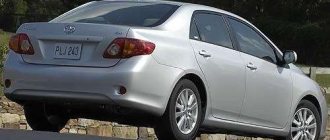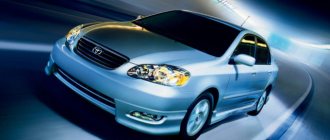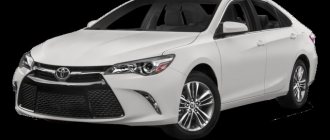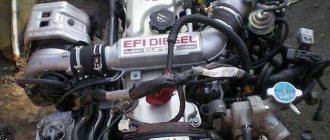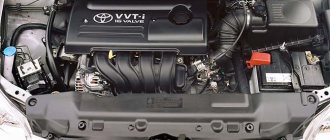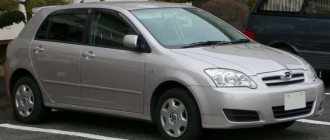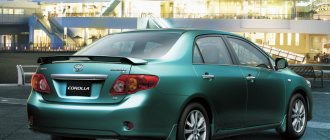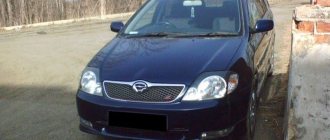Many car enthusiasts have encountered the fact that standard springs on a Toyota Corolla sagged and had to be replaced with new products. But, due to the high cost, not all vehicle owners want to replace it and are looking for alternative methods.
Videos about increasing ground clearance on the Toyota Corolla:
The video will tell you how to increase the ground clearance of your car, and also tell you about all the pros and cons of this technology.
Video - increasing ground clearance
Home ... Technical characteristics
Ground clearance (clearance) is the distance between the road surface and the lowest point of the central part of the vehicle. The higher this indicator, the lower the likelihood of damaging the bottom of the car when driving on a road surface of poor quality. The ground clearance of different Toyota Corolla models differs, but is rarely less than 150 mm.
Vehicles supplied to our country are adapted to Russian roads and have increased ground clearance, which allows them to more easily overcome uneven roads and various obstacles. If you compare the photos posted in foreign reviews, you will notice that the Corollas produced for European countries have low wing arches and fit the wheels. At the same time, in cars adapted for our country, even shock absorbers are visible in the clearance.
The ground clearance of various representatives of the Toyota Corolla model range varied depending on the body type, suspension used, and also on the number of drive wheels. Below are the ground clearance indicators of the most popular representatives of the Coroll model range:
- Toyota Corolla E-120 - 160 mm;
- Corolla Fielder CVT - 160 mm in front-wheel drive and 155 mm with all-wheel drive;
- Toyota Corolla Luxel - 170 mm;
- Toyota Corolla Sportivo - 160 mm;
- Toyota Corolla XRS - 145 mm in old models and 135 mm after restyling;
- Toyota Corolla Rumion - 135 mm in front-wheel drive models and 140 mm with all-wheel drive;
- Toyota Corolla 11th generation - 150 mm.
For Russia
restyling, 10th generation, 07.2010 - 08.2013, Sedan
| Equipment | Release period | Price | Engine make | Body brand |
| 1.3 l, 101 hp, Gasoline, manual transmission, Front (FF) | ||||
| 1.3MT Comfort | 07.2010 — 08.2013 | 642,000 rub. | 1NR-FE | NRE150 |
| 1.6 l, 124 hp, Gasoline, manual transmission, Front (FF) | ||||
| 1.6MT Comfort Plus | 07.2010 — 08.2013 | 690,000 rub. | 1ZR-FE | ZRE151 |
| 1.6 MT Elegance | 07.2010 — 08.2013 | 752,000 rub. | 1ZR-FE | ZRE151 |
| 1.6 l, 124 hp, Gasoline, automatic transmission, Front (FF) | ||||
| 1.6 AT Comfort Plus | 07.2010 — 08.2013 | 722,000 rub. | 1ZR-FE | ZRE151 |
| 1.6 AT Elegance | 07.2010 — 08.2013 | 780500 rub. | 1ZR-FE | ZRE151 |
| 1.6 AT Prestige | 07.2010 — 08.2013 | 878,000 rub. | 1ZR-FE | ZRE151 |
| 1.6 AT Elegance Plus | 07.2010 — 08.2013 | 852,000 rub. | 1ZR-FE | ZRE151 |
Toyota Corolla Ranx
Dynamics
Toyota Corolla cars released in 2010 demonstrate high quality, like previous generations. But they differ in new technical characteristics: modern design, comfortable interior and excellent dynamics.
The Corolla E150 sedan with a 1.6 liter engine with the index 1ZR-FE and a manual transmission has a top speed of 192 km/h. From a standstill it accelerates to 100 km/h in 10.4 seconds. The top speed of the Corolla with an automatic transmission is 183 km/h, accelerating to 100 km/h in almost 12 seconds.
The 1.33 liter engine of the same brand reaches a top speed of 180 km/h and accelerates to hundreds of kilometers in 13.1 seconds.
Choosing the best engine
Toyota Corolla 2008: the tenth modification of the legendary car
There are a minimum of common engine problems - a weak radiator and crankcase ventilation. The engine mounts wear out, but the silent parts are replaced separately - cheaply and effectively. The cylinder block is sensitive to overheating.
The ZZ series engines were initially heavily criticized by fans for their visually unreliable chain and piston design. Time has shown that the chain actually runs for 150 thousand kilometers and now costs a penny. Sometimes knocking noises appeared due to failures of the Corolla phase regulators, which they learned how to repair long ago. The service life of the piston group is 250 thousand kilometers, which is not enough for Japanese reliability, but excellent in comparison with competitors. Owners who change oil frequently achieve longer service life.
The 1ZZ-FE engine was constantly being improved, so take a closer look at the youngest cars possible. 3ZZ and 4ZZ lost oil consumption when changing the catalyst at the right time, replacing oil seals and cleaning the intake.
Among the common problems of the series are valve seats, which cannot be bored out, and if there is significant wear, they will have to be replaced with cast iron ones. Cast iron will last for many years, even if overheated. After 200 thousand, the valve guides wear out, which promises a very difficult repair.
NZ series engines have the same problems, and they were also installed only on Japanese cars. These motors run smoother and do not require valve adjustment. Therefore, we recommend that the buyer choose any Corolla E120 engine that he likes in terms of power, the problems are not so serious, and in the global case, contract engines are cheap.
Give up diesel engines, the engineers clearly missed the mark here.
Fuel consumption
The fuel tank capacity of the 2008 Toyota Corolla is 55 liters. Most gasoline versions of the car use AI-95 fuel; previous generations also use 92-m.
Fuel consumption (in liters) of 3 variations of Corolla E150 for different types of driving (country/urban/mixed) per hundred kilometers:
Diesel cars consume 4.4 liters, 7 liters and 5.3 liters respectively. These parameters are typical for a Corolla with a manual transmission. Automatic machines in such modes consume more, which indicates the efficiency of modifications with a diesel unit.
For comparison, the 2007 Toyota Corolla consumes 9.9 liters of gasoline per 100 km in the city and 6.5 liters on the highway.
Dimensions and weights of Toyota Corolla 2006, sedan, 10th generation, E150
| Equipment | Size, mm | Weight, kg | Ground clearance, mm |
| 1.4 MT Comfort | 4540 x 1760 x 1470 | 1270 | 150 |
| 1.3MT Comfort | 4540 x 1760 x 1470 | 1300 | 150 |
| 1.6 MT Comfort | 4540 x 1760 x 1470 | 1300 | 150 |
| 1.6 MT Elegance | 4540 x 1760 x 1470 | 1300 | 150 |
| 1.6MT Comfort Plus | 4540 x 1760 x 1470 | 1300 | 150 |
| 1.6 AT Elegance Plus | 4540 x 1760 x 1470 | 1300 | 150 |
| 1.6 AT Comfort Plus | 4540 x 1760 x 1470 | 1300 | 150 |
| 1.6 AT Elegance | 4540 x 1760 x 1470 | 1300 | 150 |
| 1.6 AT Prestige | 4540 x 1760 x 1470 | 1300 | 150 |
| 1.6 MultiMode Comfort | 4540 x 1760 x 1470 | 1300 | 150 |
| 1.6 MultiMode Elegance | 4540 x 1760 x 1470 | 1300 | 150 |
| 1.6 MultiMode Prestige | 4540 x 1760 x 1470 | 1300 | 150 |
| 1.4MT Terra | 4450 x 1760 x 1470 | 1300 | 150 |
| 1.4MT Luna | 4450 x 1760 x 1470 | 1300 | 150 |
| 1.6MT Terra | 4540 x 1760 x 1470 | 1255 | 150 |
| 1.4D MT Premium | 4540 x 1760 x 1470 | 1260 | 150 |
| 1.4D MT Luna | 4540 x 1760 x 1470 | 1260 | 150 |
| 1.4D MT Terra | 4540 x 1760 x 1470 | 1260 | 150 |
| 1.4D MultiMode Premium | 4540 x 1760 x 1470 | 1280 | 150 |
| 1.4D MT Terra | 4540 x 1760 x 1470 | 1310 | 150 |
| 1.4D MT Luna | 4540 x 1760 x 1470 | 1310 | 150 |
| 1.4D MultiMode Luna | 4540 x 1760 x 1470 | 1310 | 150 |
| 1.6MT Terra | 4540 x 1760 x 1470 | 1320 | 150 |
| 1.6MT Luna | 4540 x 1760 x 1470 | 1320 | 150 |
| 1.6MT Sol | 4540 x 1760 x 1470 | 1320 | 150 |
| 1.6MT Prestige | 4540 x 1760 x 1470 | 1320 | 150 |
| 1.6 MultiMode Luna | 4540 x 1760 x 1470 | 1320 | 150 |
| 1.6 MultiMode Sol | 4540 x 1760 x 1470 | 1320 | 150 |
| 1.6 MultiMode Prestige | 4540 x 1760 x 1470 | 1320 | 150 |
| 2.0D MT Prestige | 4540 x 1760 x 1470 | 1410 | 150 |
| 2.0D MT Premium | 4540 x 1760 x 1470 | 1410 | 150 |
| 2.0D MT Luna | 4540 x 1760 x 1470 | 1410 | 150 |
| 2.0D MT Luna | 4540 x 1760 x 1470 | 1430 | 150 |
| 2.0D MT Sol | 4540 x 1760 x 1470 | 1430 | 150 |
| 2.0D MT Prestige | 4540 x 1760 x 1470 | 1430 | 150 |
Dimensions of Toyota Corolla
Ways to enlarge
In order to change the standard ground clearance on a Toyota Corolla, some car owners install special spacers and change the chassis elements, this allows the body to be raised slightly. There are models on which a special suspension is installed, which is called air suspension, in which, thanks to special elastic pneumatic elements, you can adjust the distance between the road and the body. This eliminates the need to increase ground clearance by installing special spacers and modifying the suspension. Special reinforced racks are also installed, which add rigidity and increase ground clearance by up to 2 centimeters.
Installing spacers
In order to install special attachments, you need to do the following:
- We prepare all the necessary tools;
- Use a jack to lift the rear beam and remove the wheels;
- The rear seats fold down. The casing is moved to the side;
- The lower fastening at the rack is unscrewed;
- The upper mounting nut of the shock absorber is unscrewed;
- The fasteners are unscrewed from the trunk side;
- The stand is removed and the springs are clamped with a vice or using special pullers;
- The rod of the shock absorber is unscrewed, after which the strut is disassembled;
- A spacer is installed;
- The rack is being assembled and installed.
Installation in the front of the car is carried out in a similar way.
There are several types of air suspension installed on the Toyota Corolla:
- Lade - constant and the lowest ground clearance;
- Offroad and Straken – automatic and adjustable;
- X'tra is the permanent and largest DP.
To maintain the required distance above the road, cars with such a suspension are equipped with a special height sensor that reads the distance between the body and the axles. When the clearance changes, the automation increases or decreases the pressure in the suspension, bringing it to the desired value.
The advantages of such a suspension are as follows:
- Increased load capacity;
- The car feels more confident when cornering;
- When braking, force adjustment takes into account the load on the wheels;
- If used correctly it will last a long time.
The very first European E110 models had a height from the road of 150 millimeters, which caused a lot of discontent among our compatriots. And insufficient rigidity reduced this parameter by about two centimeters, which led to rapid wear of all the node systems that were located under the bottom. Therefore, models with a stiffer suspension were specially produced for our market. Subsequent generations in the 120 body, which began to be produced from 2000 to 2007, had a clearance of 16 centimeters.
The version in the E150 body had a different size of the parameter in question, it differed depending on the engine:
- 1.8 liter engines had 14.7 centimeters;
- 1.6 and 1.3 had 15 centimeters.
The height of 15 centimeters also remained on modifications of the Corolla in the E170 body.
Advantages of air suspension:
- large range of independent adjustment of suspension stiffness and ground clearance;
- the carrying capacity of the vehicle increases;
- the ease of turning the car increases;
- when braking, the suspension allows you to precisely adjust the force required for this, taking into account the load on each wheel;
- Air suspension is reliable and durable, provided it is used correctly.
Toyota Corolla ground clearance or ground clearance, as for any other passenger car, is an important factor on our roads. It is the condition of the road surface or its complete absence that makes Russian motorists interested in the ground clearance of the Toyota Corolla and the possibility of increasing ground clearance using spacers. To begin with, it’s worth saying honestly that the actual ground clearance of a Toyota Corolla may differ significantly from that declared by the manufacturer. The whole secret is in the method of measuring and where to measure ground clearance. Therefore, you can find out the real state of affairs only by arming yourself with a tape measure or ruler. The official ground clearance of the current generation Corolla is 150 mm; on previous versions the clearance is no more than 147 mm, and on models created for the European market it is even less. This is very little for use on our roads. Some manufacturers use a trick and declare the amount of ground clearance in an “empty” car, but in real life we have a trunk full of all kinds of things, passengers and a driver. That is, in a loaded car the ground clearance will be completely different. Another factor that few people take into account is the age of the car and the wear and tear of the springs—their “sagging” due to age. The issue can be resolved by installing new springs or purchasing spacers for sagging Corolla springs. Spacers allow you to compensate for spring subsidence and add a couple of centimeters of ground clearance. Sometimes even an inch of curb parking makes a difference.
But you shouldn’t get carried away with “lifting” the ground clearance of the Toyota Corolla, because spacers to increase ground clearance are focused only on springs
If you do not pay attention to the shock absorbers, the travel of which is often very limited, then independently upgrading the suspension can lead to loss of controllability and damage to the shock absorbers. From the point of view of cross-country ability, the high ground clearance of the Toyota Corolla in our harsh conditions is good, however, at high speeds on the highway and in corners, serious sway and additional body roll appear
Detailed video of installing spacers to increase the ground clearance of the Corolla.
Any car manufacturer, when designing the suspension and choosing the ground clearance, looks for a middle ground between handling and cross-country ability. Perhaps the simplest, safest and most unpretentious way to increase clearance is to install wheels with “high” tires. Changing wheels makes it easy to increase the ground clearance by another centimeter.
Do not forget that a serious change in ground clearance can damage the CV joints. After all, the “grenades” will have to work from a slightly different angle. But this only applies to the front axle. Moreover, a serious change in ground clearance can lead to uneven tire wear.
- carfrance.ru
- avtoklirens.com
- corollafan.ru
- myautoblog.net
Toyota Avensis T250 2003-2009
Technical characteristics of the Toyota Land Cruiser Prado Toyota Land Cruiser Prado 2.7 AT 163 hp 4WD
Avensis T250 dorestayl
Assembly of the second generation Avensis (code T250) started in 2003. Body options remain. Restyling took place in 2006, the model was produced until October 2009. The dimensions of the second generation Avensis have increased, and the ground clearance has decreased by 5 mm.
Engines and transmissions
The line of power plants was represented by four gasoline and four diesel internal combustion engines. Diesel engines were not officially supplied to Russia. The Avensis T250 transmission options are five- and six-speed manual, four- and five-speed automatic. All versions of the car have front-wheel drive.
Avensis T250 after update
Avensis options for Europe:
- 1.8, petrol, manual or automatic transmission;
- 2.0, diesel, manual transmission;
- 2.4, petrol, automatic transmission.
Pre-styling versions for the Russian market (gasoline units only):
- 1.8 manual and automatic transmission;
- 2.0 manual and automatic;
- 2.4 and automatic transmission.
1.8 1ZZ-FE manual
Main characteristics of 1ZZ-FE:
- return - 129 hp;
- moment – 170 N*m;
- compression ratio – 10;
- fuel – AI-95;
- average consumption – 7.2 l.
Station wagon Avensis T250 after update
1.8 1ZZ-FE automatic
The parameters of the same installation in tandem with automatic transmission have been preserved. The differences are as follows:
- acceleration to hundreds – 11.6 s (versus 10.3)
- speed – 195 km/h (200);
- consumption – mixed cycle (7.7).
2.0 1AZ-FSE manual
Characteristics of 1AZ-FSE:
- power – 147 hp;
- torque – 196 N*m;
- compression ratio – 11;
- fuel - AI-95;
- average consumption - 8.1.
2.0 1AZ-FSE automatic
The main indicators of the power plant are similar to those presented above. Acceleration is carried out in 11.1 s, consumption is 9.2 liters per 100 km, maximum speed is 205 km/h. The automatic transmission loses a little in terms of dynamics and consumes more fuel.
2.4 2AZ-FSE automatic
Engine performance marked 2AZ-FSE:
- exact volume – 2362 cubic meters. cm;
- return – 163 hp;
- torque – 230 N*m;
- compression ratio – 11;
- fuel consumption – 9.2 in the combined cycle.
2.0 1CD-FTV diesel manual
The installation characteristics are as follows:
- power – 116 hp;
- moment – 280 N*m;
- compression ratio - 17.4;
- average fuel consumption is 5.8 liters.
Toyota Avensis feed
Dimensions and volumes
Avensis T250 has become larger than its predecessor. Sedan dimensions:
- body dimensions – length (4630), width (1760), height (1480);
- wheelbase – 2700;
- 60 l tank;
- luggage compartment volume – 520 l;
- ground clearance - 155 mm;
- weight – 1245 kg.
Liftback parameters:
- dimensions – length (4630), width (1760), height (1480);
- base – 2700;
- tank – 60 l;
- luggage compartment volume – 510 l (1320);
- ground clearance - 155 mm;
- weight – 1320 kg.
Avensis T250 - second generation
Station wagon characteristics:
- dimensions – length (4700), width (1760), height (1525);
- base – 2700;
- tank – 60 l;
- luggage compartment volume – 520 l;
- ground clearance - 155 mm;
- weight – 1295 kg.
Chassis
The Avensis suspension is represented by a MacPherson strut, double wishbones and stabilizers. The brake mechanism is disc, and the front one is ventilated.
Protection of the driver and passengers
The basic equipment of the Avensis included driver and passenger airbags (with deactivation function), a side airbag and curtains. There was also a cushion for the driver's knees. Mounting for child seats and an additional brake light are constant attributes. The buyer also received ABS, EBD, ESP (electronic stability control) and TCS (traction control) systems. The top variant adds BAS (additional braking system) and cruise control.
Avensis T220 and Avensis T250
Restyling 2006
External changes in the new version of Avensis affected:
- front bumper;
- false radiator grille;
- fog lights;
- headlights;
- rear lights (transparent inserts appeared);
- turn signals (moved to the side mirrors, a D-CAT nameplate appeared on the wings).
2.2 2AD-FHV diesel manual
At the end of 2008, beginning of 2009, a special version with a 2.2-liter internal combustion engine was produced. Technical characteristics of the unit with common-rail direct injection:
- power – 177 hp at 3600 rpm;
- torque – 400 N*m at 2000 rpm;
- compression ratio - 16.8;
- average consumption values are 6.1 l.
Avensis T220 and Avensis T270
"Corolla" 1.3
This motor is quite rare in Russian spaces. This gasoline unit, with its volume of 1.3 liters, produces 101 horsepower. The maximum torque of a car with this engine is 132 Nm. Full power is revealed from 3.8 thousand revolutions.
Of course, for a car of this class, this engine produces weak technical characteristics. Toyota Corolla (2008) with a 1.3 engine accelerates to one hundred kilometers per hour in an “eternal” 13 and a half seconds. The maximum speed is 180 kilometers per hour.
However, the car has very moderate fuel consumption. For a hundred kilometers in mixed mode, it consumes 5.8 liters of 95. However, the car does not like overload. When fully loaded, consumption can increase by 20 percent. This is a characteristic feature of all low-power engines.
What gearbox is available for the 1.3-liter Toyota Corolla (2008)? A 6-speed manual is the only transmission equipped with this unit.
https://www.youtube.com/watch?v=Xa8XXAkc814 &feature
Chassis
The suspension of the Toyota Corolla 150 is well balanced in terms of comfort and handling. Its components withstand the bad Russian roads. The picture is spoiled by the stabilizer bushings, which last about 30,000 km. In the future, it is recommended to change them to reinforced ones with a longer service life. The front supports, made of plastic, also turned out to be weak. They start knocking after 30-40 thousand km. Subsequently, measures were taken and the support material was improved and the number of complaints was reduced.
The steering was also not up to par. After 30-40 thousand km, both the steering shaft and the steering rack were replaced. The sign is knocking and feedback in the steering wheel when driving over uneven surfaces.
Specifications
The technical equipment of the Toyota Corolla 150 boasts a high level. The front suspension is based on MacPherson struts, while the rear is represented by a torsion beam. The design allows you to feel confident on the road and provides maximum comfort. Numerous reviews on the Internet prove that the manufacturer managed to achieve the maneuverability of the sedan.
It is worth noting that cars released in 2011 differ from previous generations. A new body appears, an updated interior, and, most importantly, a semi-independent suspension. The front is represented by the MacPherson L-lever type. A stabilizer bar is also installed here. The rear part received a bump absorber on the road. In practice, this particular model is considered the most reliable, since it can withstand more than 100 thousand kilometers without repair.
Toyota Corolla 150 was produced exclusively in a sedan body with the following parameters:
- length – 4.54 meters;
- width – 1.76 meters;
- height – 1.47 meters;
- wheelbase - 2.6 meters.
The ground clearance in the new model was 15 centimeters, and the tire size was increased to 16 inches. Thanks to the increase in size, the luggage compartment has grown to 450 liters. You can often see upgraded ground clearance using spacers for shock absorbers. But there is also a flip side to the coin - a decrease in maneuverability and stability at high speeds. When decreasing, there is an increase in controllability.
The sedan is considered a family car, since the Toyota Corolla 150 is equipped with modern systems, both passive and active safety. Already in the basic configuration, ABS, supplemented by EBD, appears. In addition, there is an emergency brake booster, side and front airbags. As the configuration grows, their number increases. Elegance offers curtain airbags and a knee airbag. It is worth noting that this assembly received the highest rating in crash tests. Summing up the research, we can say that the car has become safer compared to the previous generation, both for passengers and pedestrians.
The Russian version of the popular car received only two gasoline engines. The minimum capacity is 1.33 liters and has a capacity of 101 horsepower. The second, the most powerful, reaches a horsepower of 124, and the volume increases to 1.6 liters. Both a manual and an automatic transmission can be installed with it. On the secondary market there are also examples with MMT, which in fact represents a robotic box. Unlike classical “mechanics”, the robot independently selects a gear and operates the clutch. In practice, the “robot” has proven itself to be an unreliable unit, so the version with a full-fledged “automatic” remains optimal for purchase.
Engineers paid special attention to consumption. With a minimum manual engine, consumption is 5.8 liters in the city; outside the city, consumption is reduced to 4.9 liters
The older one in similar conditions shows consumption of 6.9 and 5.8 liters. The automatic transmission slightly increases the “appetite” to 7.2 and 6.0 liters per “hundred”.
Note that for many generations the family has been distinguished by the simplicity and reliability of all components, therefore all elements have a high service life and even when moving to the “used” section they remain in demand and do not cause problems for the new owner
When choosing used cars, you should pay attention to a powerful engine and classic gearboxes - automatic or manual. On the market, in addition to the 150th version, you can find the Toyota Corolla 140 series, which was produced for the American market and was equipped with 1.8 and 2.4 liter engines
In addition to this, there are differences in appearance - DRLs appear, a pair of foglights appear at the rear, and the radiator grille changes.
Toyota Corolla prices and configurations
Spacers to increase ground clearance
Today the manufacturer offers Corolla in 6 trim levels. These are the versions Standard, Classic, Style, Comfort, Style Plus and Elegance. We will not list the countless options in various trim levels, we will tell you about the main thing. So, the basic Standard equipment of the new Corolla has a price of 898,000 rubles
. For this money you are offered a 1.3 engine, a manual transmission with 6 gears, air conditioning, power accessories (front lifts, heated front seats, electric mirrors, etc.) with 4-speaker audio. There are front airbags and a full-size spare wheel, ABS, BAC and EBD systems. The following trim levels mainly add new, more powerful powertrains and minor options.
Price of a new Corolla
in the most expensive configuration, Elegance is
1,144,000 rubles
. For this price you will get dual-zone climate control, a rear view camera with static marking lines, and a 6.1-inch color multifunctional TFT display on the center console. Safety systems include Traction Control (TRC), curtain airbags for all rows of seats, Vehicle Stability Control (VSC) and Hill Assist Control (HAC). Naturally, there will no longer be steel, but alloy wheels with 205/55 R16 tires, a stereo system with 6 speakers.
Dimensions of Toyota Corolla
of the current generation have increased if we compare the dimensions of the sedan with the previous version of Corolla. Perhaps the most significant increase in size occurred in the cabin, as the wheelbase (the distance between the front and rear axles) increased by 10 centimeters. The total body length of the new Toyota Corolla is 4,620 mm, while the previous generation of the sedan was only 4,540 mm in length. The base, which determines the space in the cabin, has increased from 2,600 mm to 2,700 mm, making the Corolla the leader in this indicator in its class. The width of the new version of the car is 1,775 mm, versus 1,760 mm. In order to improve aerodynamic performance, the body height was reduced by 5 mm.
Dimensions, dimensions of Toyota Corolla
- Length – 4620 mm
- Width – 1775 mm
- Height – 1465 mm
- Wheelbase – 2700 mm
- Front and rear wheel track – 1535/1535 mm
- Front/rear overhang – 940/980 mm
- Interior length – 1930 mm
- Interior width – 1485 mm
- Interior height – 1190 mm
- Toyota Corolla trunk volume – 452 liters
- Fuel tank volume – 55 liters
- Tire size – 195/65 R15, 205/55 R16
- Ground clearance or clearance of Toyota Corolla – 150 mm
Ground clearance Toyota Corolla
is 150 mm, while for European consumers this figure is slightly less and is 145 mm. The manufacturer specifically increased the ground clearance due to the peculiarities of the road surface in our country.
Trunk Toyota Corolla
the new generation has also become a little larger and holds 452 liters of volume, taking into account the fact that there is also a full-size spare wheel under the luggage compartment floor, this turns out to be a pretty decent figure. The rear seat backs of the Corolla fold in a proportion of 40 to 60, making the transportation of various things much more convenient, see photo.
Exterior of Toyota Corolla 2008
The body of the Toyota Corolla 2008 is very similar to that of a more advanced model: the Camry. The front part of the car is made in such a daring, even “cat-like” style with an elongated “muzzle”. The radiator grille has two horizontal stripes with a clear resemblance to an air conditioner.
The head optics have an elongated shape, still emphasizing the “cat” style of the body. Three air intakes, two of which seem to be filled with honeycombs, are separated by a thin strip of part of the bumper. The hood is smooth, like an evening lake surface.
Behind the car you can find headlights protruding outward from its body. They are divided in half by the trunk lid.
The length of the Toyota Corolla 2008 is 4.6 meters, width – 1.78 meters, height – 1.47 meters. Ground clearance is at 150 mm.
10th generation of the legendary Corolla
Toyota Corolla 2009 - side view
Interior design
Fresh door colors make them look modern, and the new dashboard color scheme is easier to read. The design of the steering wheel on the Corolla S emphasized its sporty character, and its tilt adjustment made it possible for drivers of any height to control the car comfortably.
The main multimedia display began to reflect:
- external t (°C);
- consumable fuel;
- speed;
- mileage traveled.
The modified interior provides more space and is supplemented with:
- compartment in the center of the console;
- glove compartment;
- door recesses;
- cell for glasses;
- coasters for glasses.
The changes are noticeable in different photos.
Toyota Corolla 2018 interior
The interior of the car is distinguished by its improved quality and thoughtful equipment. Thus, the following elements of the interior of an innovative car stand out:
- Stylish finish. The material used is artificial, but good quality. It can be not only synthetic soft leather, but also fabrics that are resistant to abrasion and fading in the sun. The upholstery goes well with the durable plastic that covers the panels in the cabin.
- Optimal ergonomics. A high level of usability of the interior - a modern control panel of not massive size, suitable for the class of car, comfortable seats, an angle of the seats for the seat. Adjustment and more.
- Wide space. Inside, the car feels much more spacious than it might seem from the outside.
- Electronic equipment. The console is equipped with an on-board computer and convenient screens.
- Small but nice tuning. The cabin has additional devices for holding smartphones, tablets, and there are also special cup holders.
- The panel also has an inertial unit built into it, which controls the climate in the cabin.
- There are no frills in the tunnel between the front seats. Everything is extremely simple - cup holders and keys for controlling the glass fence.
- There are 3 seats behind the front two seats. Some trim levels have armrests separating the three rear seats. But not all series have such equipment.
To this we should also add one constant factor - the trunk in terms of internal dimensions has practically remained the same. Only increased by a small distance - 452 liters. There are no thin panels on the doors. So why does the car seem so spacious inside? It turns out that high ceilings give this effect.
Salon
Let's move inside the Toyota Corolla. The inside of the car is a continuation of its design. Everything here is also very modest, yet neat. Inside you don't feel like the owner of a budget car. The tenth generation Corolla is a kind of layer between budget and business class. The front panel architecture is built smoothly and without frills. Minimum chrome parts in the interior.
The instrument panel is made in color. On the left side of the driver there is a power window control unit, and on the right there is a comfortable armrest. Under its lid there is a small compartment for storing small items.
The seats have weak lateral support. At the same time, the manufacturer did not deprive them of adjustments. Reviews from the owners say that the chair can be quickly adjusted “to suit you.” There is enough space in the back for three people. Their heads don't hit the ceiling. By the way, there is no central tunnel inside, which eats up so much free space.
Does the car have a second armrest? It is also available here. Additionally, it is equipped with two cup holders.
What is very important for the C-Class is the size of the luggage compartment. The Toyota Corolla car has a volume of 450 liters
There is also a folding function for the rear seats. This allows you to transport items of non-standard sizes. There is not enough space under the trunk floor. It's barely enough for . However, the interior is made of very high quality and takes into account ergonomics.
Specifications
| Type | Index | Volume | Power | Torque | Cylinders/valves |
| Petrol | 2NZ-FE | 1.3 l | 88 hp | 121 H*m | 4/16 |
| Petrol | 4ZZ-FE | 1.4 l | 97 hp | 130 H*m | 4/16 |
| Petrol | 1NZ-FE | 1.5 l | 110 hp | 141 H*m | 4/16 |
| Petrol | 4ZR-FE | 1.6 l | 110 hp | 150 H*m | 4/16 |
| Petrol | 1ZZ-FE | 1.8 l | 130 hp | 169 H*m | 4/16 |
| Petrol | 2ZZ-GE | 1.8 l | 136 hp | 171 H*m | 4/16 |
| Diesel | 1ND-TV | 1.4 l | 90 hp | 190 H*m | 4/8 |
| Diesel | 1CD-FTV | 2.0 l | 116 hp | 280 H*m | 4/16 |
In Russia, the car was sold with only two engines - 1.6 and 1.8 liters, but in fact the line is very extensive. There are many imported cars with different engines, so there is everything on the market. In order not to overload with unnecessary information, we have combined the characteristics of the motors in the table.
The market is mainly filled with the 1.5-liter 1NZ-FE, 1.4-liter 4ZZ-FE, and 1.6-liter 3ZZ-FE engines. The remaining units are available on used models, but in much smaller quantities.
The pair was offered with a 5-speed manual and an old 4-speed Aisin automatic. A 6-speed manual is rare. All Toyota Corolla E120 are front-wheel drive; Japanese models with all-wheel drive, connected mechanically or hydraulically depending on the gearbox, were rarely imported.
The suspension lives up to its reputation for simplicity - independent MacPherson struts at the front and a semi-independent torsion beam at the rear. The braking system has finally become completely disc and more electronic assistants have been added: ABS, EBD, BAS. The steering rack is lightened by electric power steering; cars with power steering are rare.
Technical parameters of the 1NZ-FE 1.5 l engine.
Diesel engine 1ND-TV
Toyota corolla restyling 2021, sedan, 11th generation, e180 (03.2016 - 01.2019) - technical specifications and equipment
The 1ND-TV engine is considered one of the best small diesel engines in the world. It is practically free of design flaws and at the same time is easy to repair. It belongs to the third wave of power units developed by engineers of the Toyota Motor Corporation concern in the second half of the 90s of the last century.
The 1ND-TV engine was based on a liner cylinder block with an open cooling jacket, made of light alloy materials. This engine is equipped with a VGT turbine and a SOHC gas distribution mechanism with two valves per cylinder.
This solution made it possible to rid the engine of a number of problems typical of diesel power units. However, subsequently (2005) Bosch injectors were replaced by more modern Denso, and even later - by piezoelectric type injectors. In addition, in 2008, a particulate filter began to be installed on the engine. Unfortunately, all these innovations had a negative impact on the reliability and durability of this power unit.
conclusions
For 150 Toyota Corolla bodies, a gap of up to 150 mm is typical. But for a 120 body it could be 160 or 170 mm. The best way to increase ground clearance on a Toyota Corolla. This is to install struts, which cost less than a support and spring.
Toyota Corolla. This is a class C car, one of the oldest and best-selling models of the Japanese manufacturer. The first generation model appeared in 1966 and quickly gained popularity in many countries around the world. In particular, according to the sales rating, the first Corolla was able to get into the Guinness Book of Records. Data from the 1974 show.
At that time, total sales of Toyota Corolla exceeded 25 million units, which became an absolute world record for one model. In 2006, Toyota celebrated the 40th anniversary of the Corolla. At that time, the tenth generation Corolla was released, and total sales (over 40 years) exceeded 35 million vehicles.
The famous first generation Toyota Corolla rolled off the assembly line in 1980. Many generations have changed since then, and today the 11th generation Corolla is in production. The car is known in sedans and trucks.
The engine range consists of 1.3 and 1.6 liter engines with a displacement of 99 and 122 liters. With. According.
conclusions
For the 150 Toyota Corolla body, the typical ground clearance is 150 mm. But for the 120th body it can be 160 or 170 mm. The best option for increasing ground clearance on a Toyota Corolla is to install spacers, which are low cost compared to a strut and spring.
One of the important parameters when operating a Toyota Corolla is ground clearance.
This indicator is very relevant on our roads, so when choosing a car this factor can be decisive.
Some car owners, in order to increase ground clearance, carry out a so-called suspension lift, which includes replacing some chassis elements. An excessive increase in this parameter can lead to the fact that the car’s handling at high speed will become worse, and parts will wear out faster.
Features of the body and interior
Compared to many other models in the same class, the used 10th generation Toyota Corolla is significantly superior to them. This is due not only to reliable engines or suspension. The body of the Japanese sedan is painted with a high-quality coating that prevents the metal from becoming covered with traces of corrosion. Naturally, after many years of use, rust may form. But it is extremely rare on the Corolla E150.
The interior of the Japanese model is also impossible to criticize. By modern standards, the interior looks outdated and quite simple. However, the finishing materials are of good quality. In particular, the fabric, if properly cared for, does not wear out for many years. The problems are mainly related to the plastic trim. which begins to creak. Typically these sounds originate from the glove compartment and rear parcel shelf. If the squeaks of plastic begin to irritate, soundproofing materials can be laid in problem areas.
Before purchasing a used Toyota Corolla 2012 in the E150 body, it is recommended to diagnose the on-board electronics, paying special attention to the condition of the fuses. They are the ones that most often melt, causing the air conditioning unit and other equipment to stop working.

